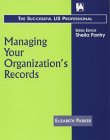Managing your Organization’s Records

Library Association Publishing
1999
Paperback
192pp
£14.95
ISBN 1 85604 335 5
Description
This book deals with records management as an independent professional discipline with its own body of theory and practice. It aims to develop the LIS professional’s understanding of the basic principles involved in managing records effectively, understanding the benefits of good record management and receiving sound advice on the practical steps they can take to establish and exercise proper control over records in their care.
Topics include:
- identifying and managing records
- servicing your organization through record management
- managing active records
- managing inactive records
- how to manage e-mail
- retention of records
- managing records through organizational upheaval
- disaster planning of vital records and business recovery
- promoting the records management service.
Reviews
‘… this could prove a useful emergency primer to someone thrown in at the deep end of records management. It could certainly be recommended to students wanting an insight into what this concept involves in the ‘real world’, as a complement to more theoretical treatments.’
Education for Information
‘Useful, practical, easy to read? Yes.’
LASIE
Records management made persuasive
Records management may not be a topic to set the pulse racing but records are, without question, one of the most valuable and most under-utilised resources that organisations possess. Elizabeth Parker’s book aims to show the reader how to manage records effectively, efficiently and economically. The practical approach makes this volume particularly accessible to the general reader and the non-specialist, although it will also be of value to those with some experience of this field.
As with other volumes published by LA Publishing, this work is aimed primarily at the library and information services market, with an emphasis on continuing professional development and the management of an ever-changing portfolio of skills. However, it would also be a very useful resource for others such as general managers, office administrators and students of records management.
The book sets out to provide a comprehensive overview for non-specialists and is extremely successful in achieving this aim. It is particularly notable for its readable, informal style, the author taking her own advice and “making it easy for people to do what they have to do”. The practical, illustrative nature of the text – which makes extensive use of real-life situations, case-studies and exercises for the reader to work through – make this an interesting and worthwhile read.
Exceptionally clear organisation of the text (as you would hope in a book on records management!), makes the book both easy to read and easy to find your way around. The three sections (‘records and records management’, ‘managing records’ and ‘managing your organization’s records’) follow a logical progression and the chapters within each section tackle important issues and give recommendations on how to develop a framework for records management within your own organisation.
Additionally, the index is concise and there are useful appendices on ‘getting help’ (a list of addresses) and ‘further reading’, which includes British and International Standards and web links. It is, however, the inclusion of simple and logical procedures for the management of electronic files, including email, which make this volume such an important and timely addition to the existing texts on records management.
The illustration of these routines with diagrams and screenshots, makes them readily understandable and should provide the impetus for many an information professional to sort out their hard drive!
As an introduction to records management, outlining the broad principles of the subject, Elizabeth Parker’s book is hard to fault. It is more comprehensive and up to date than a similar volume in the ASLIB ‘Know How’ series, although it is recognised in the introduction that the topic cannot be dealt with in great detail in a work of this size.
Despite the conciseness of this volume, the superior clarity of its content and layout, combined with judicious use of diagrams, check lists, examples and case studies provide ample supporting evidence to illustrate the principles involved.
Given that managing an organisation’s records is, to a greater or lesser extent, everybody’s responsibility, this book would be a valuable addition to the shelves of both information professionals and managers. It is a convenient size, extremely readable and well worth the cover price of £13.50.
Overall, this volume can be highly recommended both for the clarity of its layout and the ease with which it can be read.
At first glance, not a records management might not appear to be topic of much general interest. Elizabeth Parker does, however, manage to present persuasive arguments for the benefits of records management and her own obvious enthusiasm is conveyed with her practical advice and anecdotal evidence. For all but the most experienced records management specialist, this book represents an excellent buy.
| Ease of use |
|
|---|---|
| Content |
|
| Value for money |
|
Helen Carter, Electronic Services Librarian, Eastleigh College, Hampshire
Information World Review, April 2000, p. 27
Available at a 20% discount to Chartered Institute of Library and Information Professionals members.
Remember to quote your Membership Number if claiming the discount.
Facet Publishing, 7 Ridgmount Street, London WC1E 7AE, UK
www.facetpublishing.co.uk
Available from Bookpoint Ltd, Mail Order Department, 130 Milton Park, Abingdon, Oxon OX14 4SB
Tel: +44 (0)1235 827702. Fax: +44 (0)1235 827703.
Email: facet@bookpoint.co.uk